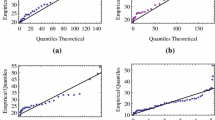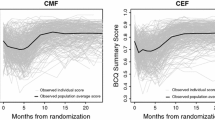Abstract
In this work, we consider semiparametric estimation of quality adjusted lifetime (QAL) distribution using Cox proportional hazards model for the sojourn time in each health state. The regression coefficients are estimated by maximizing the corresponding partial likelihood and the baseline cumulative hazards are estimated by using the method of Breslow (Biometrics 30:89–99, 1974). The estimate of QAL distribution is obtained by using these estimates in the theoretical expression of QAL distribution. The asymptotic normality of the proposed estimator is established. The performance of the proposed estimator is studied using Monte Carlo simulation. A real data example of the Stanford Heart Transplant Program is used to illustrate the proposed method. Extension to a general model is also discussed and illustrated with an analysis of International Breast Cancer Study Group (IBCSG) Trial V data.




Similar content being viewed by others
References
Andersen, P.K., O. Borgan, R.D. Gill, and N. Keiding. 1993. Statistical models based on counting processes. New York: Springer.
Breslow, N.E. 1974. Covariance analysis of censored survival data. Biometrics 30:89–99.
Cole, B.F., R.D. Gelber, and A. Goldhirsch. 1993. Cox regression models for quality adjusted survival analysis. Statistics in Medicine 12:975–987.
Cox, D.R. 1972. Regression models and life-tables (with discussion). Journal of the Royal Statistical Society Series B 34:187–220.
Crowley, J., and M. Hu. 1977. Covariance analysis of heart transplant survival data. Journal of the American Statistical Association 72:27–36.
Goldhirsch, A., R.D. Gelber, R.J. Simes, P. Glasziou, and A. Coates For the Ludwig Breast Cancer Study Group. 1989. Costs and benefits of adjuvant therapy in breast cancer: A quality adjusted survival analysis. Journal of Clinical Oncology 7:36–44.
Huang, Y., and T.A. Louis. 1998. Nonparametric estimation of the joint distribution of survival time and mark variables. Biometrika 85:785–798.
Huang, Y., and T.A. Louis. 1999. Expressing estimators of expected quality adjusted survival as functions of Nelson–Aalen estimators. Lifetime Data Analysis 5:199–212.
Hwang, J.S., J.Y. Tsauo, and J.D. Wang. 1996. Estimation of expected quality-adjusted survival by cross-sectional survey. Statistics in Medicine 15:93–102.
Korn, E.L. 1993. On estimating the distribution function for quality of life in cancer clinical trials. Biometrika 80:535–542.
Pradhan, B., and A. Dewanji. 2009a. Parametric estimation of quality adjusted lifetime (QAL) distribution in progressive illness–death model. Statistics in Medicine 28:2012–2027.
Pradhan, B., and A. Dewanji 2009b. Parametric estimation of quality adjusted lifetime (QAL) distribution for two general illness–death models. Calcutta Statistical Association Bulletin 61:33–59.
Pradhan, B., and A. Dewanji 2010. Nonparametric estimator for the survival function of quality adjusted lifetime (QAL) in a three-state illness–death model. Journal of the Korean Statistical Society 39:315–324.
Pradhan, B., A. Dewanji, and D. Sengupta. 2010. Parametric estimation of quality adjusted lifetime (QAL) distribution in simple illness–death model. Communications in Statistics: Theory and Methods 39:77–93.
Shu, Y., J.P. Klein, and M.-J. Zhang. 2007. Asymptotic theory for the Cox semi-Markov illness–death model. Lifetime Data Analysis 13:91–117.
Tunes-da-Silva, G., A.C. Pedroso-de-Lima, and P.K. Sen. 2009. A semi-Markov multistate model for estimation of the mean quality-adjusted survival for non-progressive processes. Lifetime Data Analysis 15:216–240.
van der Laan, M.J., and A. Hubbard. 1999. Locally efficient estimation of the quality-adjusted lifetime distribution with right-censored data and covariates. Biometrics 55:530–536.
Voelkel,, J.G., and J. Crowley. 1984. Nonparametric inference for a class of semi-Markov processes with censored observations. Annals of Statistics 12:142–160.
Wang, H., and H. Zhao. 2007. Regression analysis of mean quality-adjusted lifetime with censored data. Biostatistics 8:368–382.
Zhao,, H., and A.A. Tsiatis. 1997. A consistent estimator for the distribution of quality adjusted survival time. Biometrika 84:339–348.
Zhao, H., and A.A. Tsiatis. 1999. Efficient estimation of the distribution of quality adjusted survival time. Biometrics 55:1101–1107.
Zhao, H., and A.A. Tsiatis. 2000. Estimating mean quality adjusted lifetime with censored data. Sankhyā, Series B: Special Issue on Biostatistics 62:175–188.
Acknowledgements
The authors thank the International Breast Cancer Study Group for providing the data used in Section 6. The authors would also like to thank an anonymous referee for helpful comments.
Author information
Authors and Affiliations
Corresponding author
Appendix
Appendix
Let us assume the regularity conditions 1–3 of Shu et al. (2007). Theorem 1 is Lemma 1(ii) of their work.
Proof of Theorem 2
Using Lemmas 1 and 2 of Shu et al. (2007),
where
Note that, for each q, the right hand side of Eq. 15 is essentially a sum of n independent and identically distributed zero-mean random variables. Using the arguments of Shu et al. (2007), we conclude that \(\sqrt{n}\big[\hat{S}_0(\cdot ; {\bf Z}_0)-S_0(\cdot; {\bf Z}_0)\big]\) converges weakly to a zero-mean Gaussian process with covariance function at \(\left(\frac{q}{w_0}, \frac{q'}{w_0}\right)\) given by
which, for q = q′, can be estimated uniformly consistently by Eq. 7 in Section 3.□
Proof of Theorem 3
Following the similar decomposition technique as that used in Voelkel and Crowley (1984) and Shu et al. (2007), we have
where
Note that, for each q, the right hand side of Eq. 16 is essentially a sum of n independent and identically distributed zero-mean random variables. Using the arguments of Shu et al. (2007), we conclude that \(\sqrt{n}\left[\hat{P}_{12}(\cdot)-P_{12}(\cdot)\right]\) converges weakly to a zero-mean Gaussian process with covariance function at \(\left(\frac{q}{w_0}, \frac{q'}{w_0} \right)\) given by
which, for q = q′, can be estimated uniformly consistently by Eq. 8 in Section 3.□
Proof of Theorem 4
Note that
Hence, by some rearrangement of terms and following the techniques used in the proofs of Theorems 2 and 3, \(\sqrt{n}\left[\hat{S}_{Q}\left(q; {\bf Z}_0\right)-S_{Q}\left(q; {\bf Z}_0\right)\right]\) can be written as a sum of n independent and identically distributed zero mean random variables. The weak convergence result follows by using similar arguments. The covariance term in Theorem 4 is given by
which can be estimated uniformly consistently by Eq. 10 in Section 3.□
Rights and permissions
About this article
Cite this article
Pradhan, B., Dewanji, A. Semiparametric estimation of quality adjusted lifetime distribution in semi-Markov illness–death model. Sankhya B 73, 81–104 (2011). https://doi.org/10.1007/s13571-011-0020-1
Received:
Revised:
Accepted:
Published:
Issue Date:
DOI: https://doi.org/10.1007/s13571-011-0020-1




